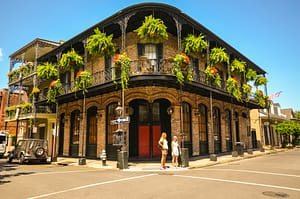New Orleans history only really began in 1718, in an area already settled by the Chitimacha Native Americans for several hundred years. Named after the then Regent of France, the Duc d’Orleans, the trading post became profitable and attracted settlers almost from the outset. However, in 1763 the area was passed to the Spanish Empire as part of the Treaty of Paris and it remained in Spanish hands until 1801, when it was returned to the French.
Due to its strategic location on the Mississippi Rover and its port, New Orleans played a crucial part in America’s struggles to free the country from British domination. Weapons, military equipment and other supplies were landed in New Orleans and smuggled upriver to the rebels stationed farther inland, and in 1779 a decisive campaign was launched from the city by Bernardo Gálvez y Madrid, a notable Spanish nobleman.
Having got his hands on New Orleans in 1801, Napoleon Bonaparte sold the city and its glorious 18th-century Spanish-style architecture to the US government as part of the Louisiana Purchase in 1803. The sale opened the door to an influx of Irish, German, African, Creole and French immigrants, as well as American nationals. Slave labor on the cotton and sugar plantations grew apace during this period in the history of New Orleans.
The city’s fascinating link with the practice of voodoo came about after the Haitian Revolution (1791 to 1804), when Haitian refugees poured into the city. Both white settlers and free people of color arrived, with many transporting their slaves to the new land. Initial immigrants from the troubled island were soon followed by Haitians formerly settled in Cuba, thus beginning the city’s unique multi-cultural ambience and history.
In 1812, British Empire forces, already at war with France, attacked America again with the aim of forcing the independent country back into the Empire. At sea and on land in the south of America, the conflict raged, with merchant ships destroyed and British forces once again on American land.
The Battle of New Orleans, in 1815, was a decisive American victory, resulting in the withdrawal of the British armies occupying Louisiana. It was Andrew Jackson, future president, who took on 11,000 British troops successfully, and interestingly the final decisive battle took place on January 8th, oblivious to the fact that a peace pact had already been agreed two weeks earlier in Ghent.
During 20th-century New Orleans history, economic predominance in the region was taken over by other massive southern cities, including the likes of Atlanta, Dallas, Houston and also Miami, and its population declined as a result, particularly within its central districts. The city was at the heart of the Civil Rights Movement in the 1960s, with school desegregation an explosive issue.
By the 1980s, the city’s economy was mostly in the hands of its majority African-American community and tourism began to boom, bringing with it comparative prosperity and suburban development. Tragedy struck in 2005, when Hurricane Katrina caused the poorly designed and maintained levee system to fail, flooding 80 percent of New Orleans and resulting in widespread devastation, but fortunately sparing the historic French Quarter.

